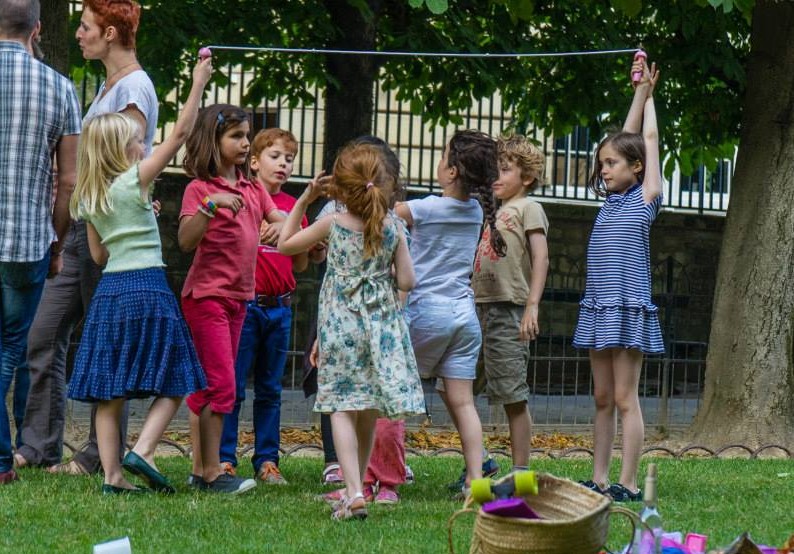Google the definition of play and the first thing that pops up is this: “[To] engage in activity for enjoyment and recreation rather than a serious or practical purpose.”
Jack Shonkoff, the director of the Center on the Developing Child at Harvard University, finds that language supremely frustrating. “It’s not taking a break from learning when we talk about play,” he told me, rattling off a litany of cognitive, physical, mental, and social-emotional benefits. “Play is one of the most important ways in which children learn.”
But in the mid-2000s, the federal No Child Left Behind education law—which emphasized test scores—prompted some schools to scale back recess (along with art and music) to spend more time on math and reading. Other schools eliminated recess because it was the source of a disproportionate number of discipline issues and a headache for administrators. The rollback wasn’t quite as extreme as some of the headlines seemed to indicate (After all, what better way for opponents of the law to push back than to put out the word that recess was on the chopping block?), but it did leave hundreds, even thousands, of kids without time during the school day to play outside. Some studies suggested that as many as 40 percent of school districts across the country reduced or cut recess. Even today, only a handful of states actually require recess. And many of the students affected by recess cuts were low-income children, disproportionately black and Latino, who didn’t always have a safe space to play outside at home.
Yet while that was going on, the science showing the benefits of play was also growing increasingly robust. Galvanized by both the rollback of recess in some places and the stronger science backing play, and bolstered by a relatively new focus in education on social-emotional learning, preventing bullying, and reducing childhood obesity, recess has made something of a comeback. According to a report put together by the Centers for Disease Control and Prevention (CDC), about 95 percent of kindergartners have recess. But that figure drops to 91 percent for 5th grade, and only about 35 percent of the elementary schools that offer 6th grade give those students a recess period.
As recess rebounds, albeit not as swiftly as some would like, advocates have begun to make headway not only in bringing play to more schools, but in making sure that play at recess benefits all children and not just the most vocal or outgoing.
Jill Vialet founded Playworks, which works with schools to give kids opportunities to play safely and meaningfully, in 1996 after speaking with a principal in Oakland, California, who complained that recess had devolved into the most fraught part of the day for educators. The idea that play should happen organically and without adult direction might sound nice, but that wasn’t a reality for what turned out to be a lot of schools.
This year, the nonprofit has reached about 1,200 schools, or about 700,000 students, in 23 cities across the United States.* Most of the students in the schools Playworks works directly with are poor, and the vast majority are students of color. This week, Playworks is announcing a new push to reach 7,000 elementary schools serving 3.5 million kids, or about 10 percent of elementary schools, by 2020. “Ultimately if we could put ourselves out of business, that would be a success,” Vialet said.
That’s a lofty goal, but the group is gaining momentum and has picked up some $26 million in funding from groups like the Einhorn Family Charitable Trust and the Horace W. Goldsmith Foundation. And where the group has frequently sent its own trained coaches into schools, Playworks will increasingly focus on training people already working in schools in how to facilitate play. “Play is the way we teach the newest members of our community the social mores that make civil society function,” Vialet said. “I think our democracy depends on it.”
Pepe Gonzalez is the principal of Laurel Dell, an elementary school in San Rafael, California, about 15 miles north of San Francisco. Before his school turned to Playworks, kids involved in minor playground scuffles used to make their way to his office for mediation. Teachers were spending valuable time after the bell rang trying to resolve who had shoved whom, which was eating into math and reading. After Gonzalez heard about the organization from a nearby school that had gotten a grant to use it, he and several other schools teamed up last year to try it out. For one week a month, a Playworks coach spends time on campus teaching kids games and facilitating positive interactions among students. For the other three weeks, a teacher at the school who has been trained by Playworks and a team of trained junior coaches (fourth- and fifth-graders) rove the playground during recess, starting games, mediating disputes, and encouraging everyone to join in. Whenever the Playworks coach is on campus, he takes time to meet with the teacher and junior coaches to teach them new games and talk strategy, and they meet without him weekly. “It changed what students were doing every day,” Gonzalez said.
Kids who might have sat off to the side, too nervous to participate, feel secure enough to join a game of Four Square. A pack of kids who used to dominate the soccer field while others looked on might now open up to more students through Playworks’s “line soccer” game, which involves constant turnover among the teams. A fourth-grade junior coach might oversee a game of Rock-Paper-Scissors to solve a dispute over whose turn it is, preventing a grudge from festering. A pile of hula hoops that used to sit untouched might now be a favorite toy. “It sets a tone where everyone is safe to try,” said Elizabeth Cushing, the president and chief operating officer of Playworks.
Discipline rates are down, and that’s not unique to Laurel Dell. According to Playworks’s 2016 annual survey of more than 7,400 teachers and school staff, conflicts have decreased, cooperation is up, and students are more likely to focus and participate in classroom activities. While that survey is internal, a 2012 trial conducted by researchers at Mathematica Policy Research and Stanford University found similar benefits.
But isn’t there an argument to be made in favor of unstructured play? Don’t kids need a chance to just “be kids,” and is it really wise for adults to encroach on their playground domain? The structured-unstructured dichotomy is “really a false choice in my mind,” Vialet, who acknowledges that the organization has received some pushback for being too structured, said. Kids, she said, are allowed, even encouraged, to create their own games and rules; Playworks simply gives them the tools to do that.
Without structure, Vialet said, there are fewer opportunities for kids to be successful in directing their own play. And Playworks coaches can’t be everywhere at once, said Cushing. Coaches will start a game, teach the kids how to play, make sure they’ve got it, and then move to a different part of the playground. “With increased structures, that actually creates opportunities to play more games,” Gonzalez said. “There’s more interaction.”
Harvard’s Shonkoff—who also dislikes the term recess “because it implies withdrawing or disengaging from the serious business of school”—said that where some kids are able to engage in free, unstructured play on their own, without much prodding, others may need more “scaffolding” or coaching in how to play, particularly if they’ve grown up in a home or neighborhood where they haven’t had the time and space to direct their own play. And, he said, the “right” kind of play can produce the “right” kind of academic achievement because, regardless of the situation, kids will be learning valuable skills. What really matters, he said, is that kids are surrounded by adults both in the classroom and on the playground who are trained in child development.
The CDC has been funding research about how to improve physical education and recess in schools, and in November will release a brief outlining strategies schools can use to foster a positive recess experience. Francesca Zavacky, a senior program manager with the Society of Health and Physical Educators who has been working with the CDC, said she’s worked in schools where adults simply stood off to the side, as far away from the children as possible, during recess. “There was absolutely no training,” she said. Schools, she said, need to have clear policies around recess and refrain from tying it to discipline. “It’s not appropriate to use [taking recess away] as a bargaining chip for behavior,” she said. Nor is it appropriate to assign laps as punishment. “We don’t want to associate physical activity with punishment,” she said.
From all corners—academic, health, and even business (recess helps kids develop the “soft skills” that companies now find themselves trying to instill in new workers)—there appears to be a renewed focus on the possibilities when recess is done right. And while not every school is going to be able to pay the $23,000 to $32,000 per year that a Playworks coach costs (depending on the region), Vialet and Cushing hope that they can train enough people and partner with enough organizations that the idea of recess as a headache to be suffered through disappears. “We’re trying to essentially feed a movement,” Cushing said.
Vialet is reluctant to base that entire movement on improving behavior or test scores, though. Quoting the philosopher Bernard Suits, who said that “playing a game is a voluntary attempt to overcome unnecessary obstacles,” she pointed out what many adults seem to forget: Play should be fun. Play should give kids volition. “It matters how it feels,” she said.
Beyond that, while the economy used to depend on an education system that produced young people capable of rote memorization, of being cogs in a machine, the modern economy is much more demanding. There’s much more pressure for children to be able to problem solve and work in teams. And there’s a deeper scientific understanding that play fosters that kind of learning. “The North Star in all of this,” Shonkoff said, reiterating a point from the beginning of our conversation, “is that play is not the alternative to learning.” In other words, recess is not a distraction from school, it is an important component of it.







